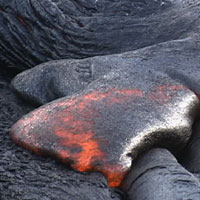Join us for conversations that inspire, recognize, and encourage innovation and best practices in the education profession.
Available on Apple Podcasts, Spotify, Google Podcasts, and more.

Lava at the Hawaii Volcano
Observatory.
During this session you will have an opportunity to build understandings to help you:
The theory of plate tectonics represents a unifying set of ideas that have great power in explaining and predicting major geologic events. In this session, we continue to explore this theory by focusing on how it is possible for tectonic plates to move. This leads us to examine Earth’s internal structure and the dynamic nature of its interior, which reveals another story of the Earth that rocks can tell.
How is it possible for tectonic plates — giant masses of rock the size of continents and oceans — to move? To better understand the theory of plate tectonics, we need to understand what is happening inside the Earth. No one has ever journeyed to the center of the Earth, except in the movies. What would such a journey reveal about the interior of the Earth?
In the video, our journey starts at the Earth’s surface. Just what is a tectonic plate? And how do we know that plates move? Dr. Keith Klepeis, who studies plate boundaries, offers evidence from current scientific theory to help us answer these questions, which lead us to questions about lava: What is lava, what clues does lava give us about the Earth’s interior, and how is lava connected to plate movement? Dr. Dave Sherrod, a volcanologist with the Hawaiian Volcano Observatory, takes us to an active lava flow as a starting point for building answers, with earthquakes becoming an important source of evidence.
During the video, we watch interviews that highlight children’s ideas about how continents move and Earth’s internal structure. We also visit Keedar Whittle, a science coordinator in Dorchester, Massachusetts, and listen in as his sixth graders discuss earthquakes and the nature and source of lava.